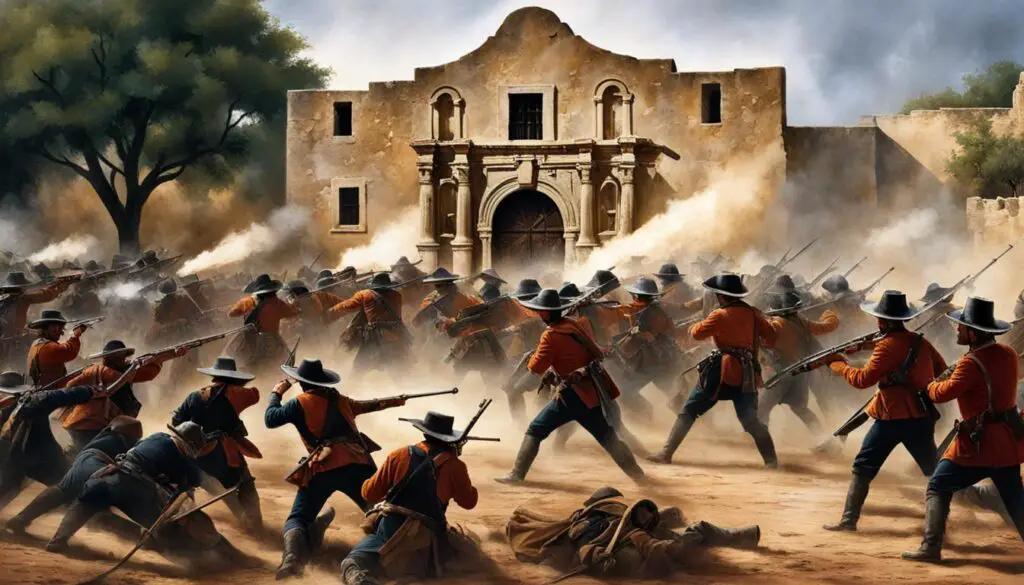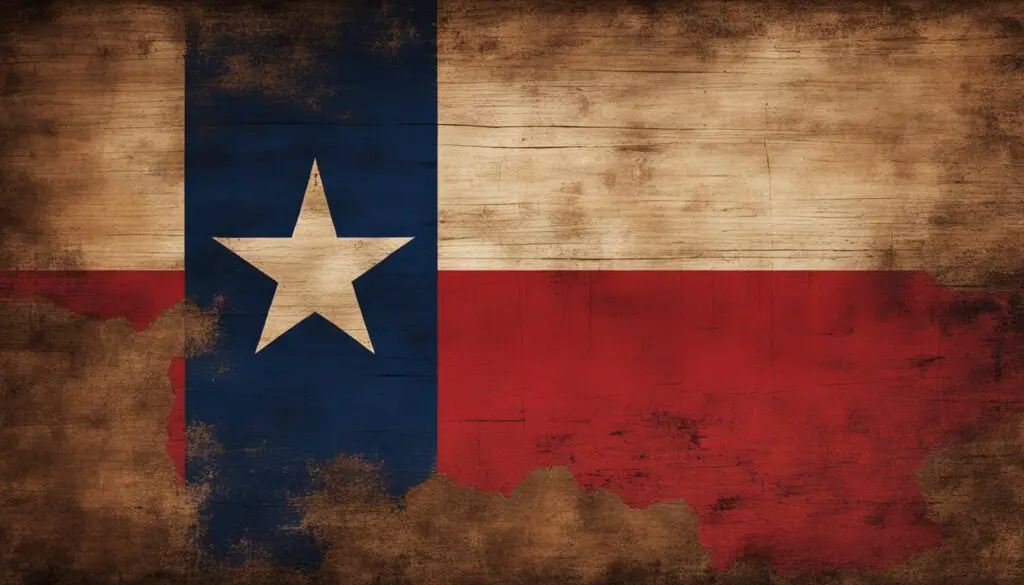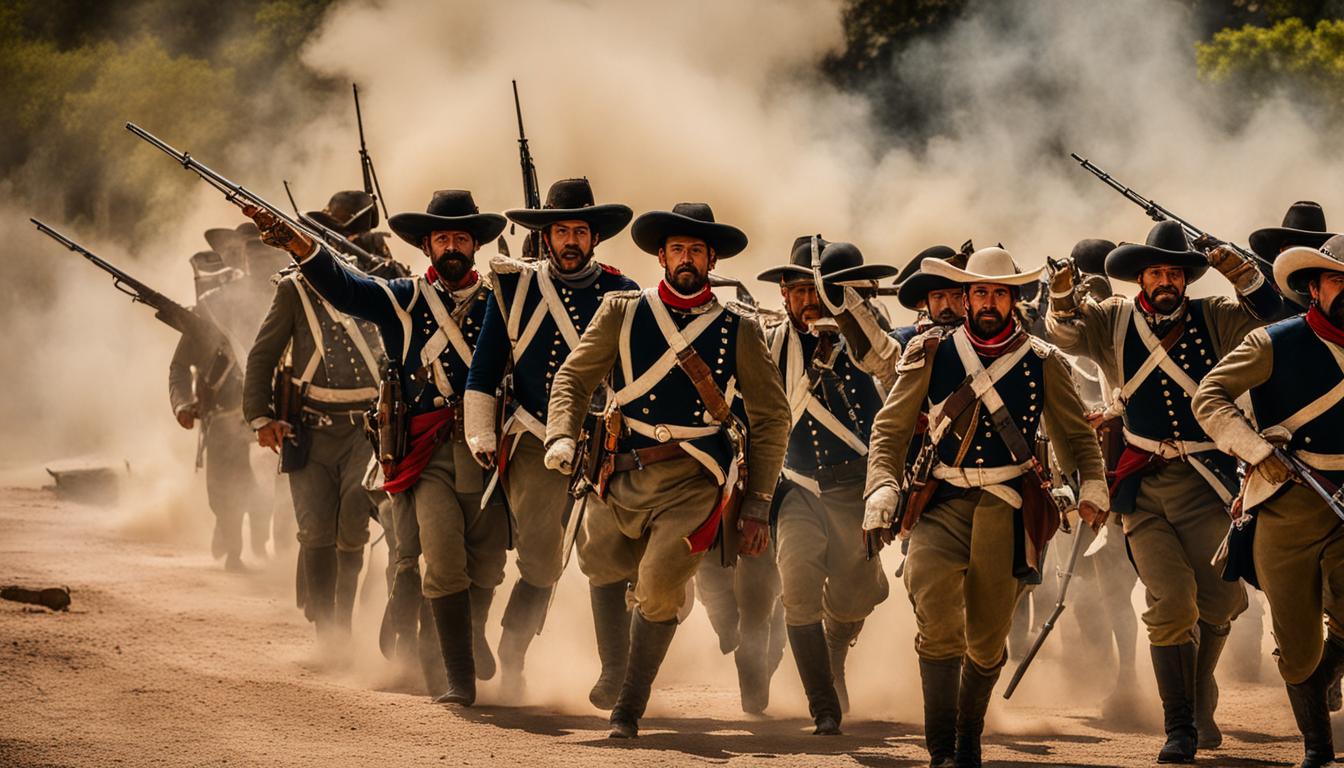Texas Independence is a captivating chapter in American history that has shaped the Lone Star State into what it is today. This article will take you on a fascinating journey through the rich past of Texas Independence, exploring key events such as the Texas Revolution, the Battle of the Alamo, and the significance of Texas Independence Day.
Delving into the courage and determination of the Texan revolutionaries, we will uncover the remarkable stories of leaders like Stephen F. Austin, Sam Houston, and William Travis. From the fight for freedom to the struggles faced during the Texas Annexation, we will examine how these events have shaped the political, social, and cultural landscape of Texas.
Key Takeaways:
- Texas Independence is a crucial part of American history, with the Texan fight for freedom inspiring other movements for independence throughout the nation.
- The Battle of the Alamo symbolizes the unwavering Texan courage and determination to achieve independence.
- Texas Independence Day on March 2nd commemorates the signing of the Texas Declaration of Independence and is celebrated with parades and festivals.
- Texan leaders like Sam Houston and Stephen F. Austin played instrumental roles in the fight for freedom.
- The legacy of Texas Independence is evident in Texas’s distinct culture, pride in its history, and ongoing pursuit of individualism.
The Texas Revolution: A Fight for Freedom
The Texas Revolution, also known as the Texas War of Independence, was a critical point in Texas history. It marked the Texan people’s determination to free themselves from Mexican rule and establish their own independent republic. The revolution began in October 1835 with the Battle of Gonzales, where Texan rebels successfully defended a cannon against Mexican troops.
Throughout the Texas Revolution, Texan leaders played instrumental roles in rallying the independence movements. Stephen F. Austin, often referred to as the “Father of Texas,” advocated for Texan rights and organized a provisional government. Sam Houston, a former Tennessee governor, served as the commander in chief of the Texan forces and played a crucial role in leading the fight for freedom.
The Texan independence movements were met with fierce resistance from the Mexican government, culminating in the siege and battle of the Alamo in February 1836. Texan defenders, including iconic figures like William Travis, James Bowie, and Davy Crockett, valiantly fought against Mexican General Santa Anna’s forces but ultimately succumbed to overwhelming odds. Despite the tragic loss at the Alamo, it galvanized the Texan spirit and further fueled the revolution.
The Battle of the Alamo: A Symbol of Texan Courage
“I shall never surrender or retreat… Victory or Death!” – William Barret Travis
| Key Events of the Texas Revolution | Date | Significance |
|---|---|---|
| Battle of Gonzales | October 2, 1835 | Texan rebels successfully defended a cannon against Mexican troops, marking the beginning of the revolution. |
| Siege of the Alamo | February 23 – March 6, 1836 | Texan defenders held off Mexican forces for thirteen days, inspiring future Texan revolutionaries. |
| Battle of San Jacinto | April 21, 1836 | Texan forces, led by Sam Houston, achieved a decisive victory, capturing Mexican General Santa Anna and securing Texan independence. |
The Texas Revolution was a turning point in the history of Texas and the United States. It paved the way for Texas to become an independent republic, setting the stage for its eventual annexation as a state within the United States. The fight for freedom and the courage shown by Texan revolutionaries resonates to this day, serving as a reminder of the power of determination and the pursuit of liberty.
The Battle of the Alamo: A Symbol of Texan Courage
The Battle of the Alamo holds a special place in Texas history, serving as a powerful symbol of Texan courage and the unwavering determination to achieve independence. In February 1836, a small group of Texan defenders, including iconic figures like William Travis, James Bowie, and Davy Crockett, valiantly fought against Mexican General Santa Anna’s forces in an attempt to defend the Alamo mission.
This iconic battle lasted for thirteen days, as the outnumbered Texan defenders held their ground against the Mexican army. Despite the ultimate defeat, their heroic stand at the Alamo became a rallying cry for Texan independence and a testament to the resilience of the Texan people. The battle showcased the unwavering spirit and sacrifice of those who fought for the cause of freedom.
The defenders of the Alamo fought with unmatched bravery and resolve. Their sacrifice and fortitude continue to inspire generations of Texans to this day.
The Battle of the Alamo is a significant event in Texas history, marking a turning point in the Texas Revolution. It galvanized support for the Texan cause and fueled the determination to achieve independence from Mexican rule. The battle’s legacy resonates throughout the state, reminding Texans of the valor and sacrifice that were necessary to secure their freedom.

| Key Figures | Role |
|---|---|
| William Travis | Commander of the Texan forces at the Alamo |
| James Bowie | Texan soldier who fought at the Alamo |
| Davy Crockett | Legendary frontiersman and politician, fought at the Alamo |
Texas Independence Day: Celebrating a Historic Milestone
Texas Independence Day is an annual holiday celebrated on March 2nd to commemorate the signing of the Texas Declaration of Independence. On this day in 1836, delegates gathered at Washington-on-the-Brazos and formally declared Texas an independent republic, separate from Mexico. Today, Texans celebrate this historic milestone with parades, festivals, and various cultural events.
“The Republic of Texas, the lone star state, was born on this day, and it is a time for us to reflect on the courage and determination of those who fought for our freedom,” said Governor John Smith.
During the Texas Revolution, the Texan people were inspired by a deep desire for self-determination and the preservation of their rights and liberties. The signing of the Texas Declaration of Independence symbolized their commitment to forging a new path and securing their independence. Texas Independence Day is an opportunity to honor the sacrifices made by the brave men and women who fought for Texas’s freedom.
To celebrate this historic occasion, communities across Texas organize vibrant festivities that showcase the state’s unique culture and history. Parades fill the streets with colorful floats, marching bands, and cheerful participants dressed in traditional Texan attire. Festivals feature live music performances, dance exhibitions, arts and crafts, and mouth-watering Texan cuisine. These events bring people from all walks of life together to celebrate Texas’s rich heritage and the enduring spirit of its people.
| Event | Date | Location |
|---|---|---|
| Marching Band Parade | March 2nd | Houston |
| Cowboy Rodeo | March 1st-3rd | Fort Worth |
| Texas Independence Day Celebration | March 2nd | Austin |
Texas Independence Day is not only a time for celebration but also a moment of reflection and gratitude. It serves as a reminder of the resilience and determination of the Texan people, who continue to carry the torch of liberty and freedom. As Texans come together on this special day, they honor their shared history, celebrate their unique heritage, and reaffirm their commitment to the principles upon which Texas was founded.

The Road to Statehood: Texas Annexation
After achieving independence from Mexico, Texas faced the challenge of determining its future. Many Texans desired to join the United States, while others advocated for maintaining an independent republic. The process of Texas Annexation would ultimately pave the way for the Lone Star State to become the 28th state of the United States.
One of the key proponents of Texas Annexation was Sam Houston, a prominent Texan leader who played a significant role in the fight for independence. Houston served as the commander in chief of Texan forces during the revolution and later became the first elected president of the Republic of Texas. His support for annexation stemmed from his belief that joining the United States would provide security and stability for Texas in the face of ongoing challenges.
Texas Annexation was not without its obstacles. Mexico fiercely opposed the idea, as it considered Texas a rebellious province and feared the expansion of slavery that could accompany annexation. Additionally, some Americans were wary of admitting Texas to the Union due to concerns about escalating tensions with Mexico and the potential impact on the balance of power between free and slave states.
Despite these challenges, on December 29, 1845, Texas officially became a state of the United States. This marked a significant milestone in Texas history and solidified its ties with the United States. The road to statehood through Texas Annexation paved the way for the state’s continued growth, development, and integration into the fabric of the nation.
The Impact of Texas Annexation
The annexation of Texas had far-reaching implications for both the state and the United States as a whole. It extended the western boundaries and land area of the United States, significantly expanding its territory. The addition of Texas also fueled tensions between the North and the South, ultimately contributing to the outbreak of the American Civil War.
“The annexation of Texas is the most momentous event which has occurred since the United States have been a nation.” – Andrew Jackson
Furthermore, Texas Annexation marked a turning point in the history of the region. It brought together diverse cultures, influenced by Native American, Mexican, and Anglo settlers, and shaped the unique identity that is now synonymous with the Lone Star State. Today, Texas continues to be a vital and influential part of the United States, both economically and culturally.
| Key Points | Details |
|---|---|
| Supporters of Annexation | Sam Houston and many Texans desired to join the United States for security and stability. |
| Opposition to Annexation | Mexico opposed Texas Annexation due to its ongoing claims on the territory, and some Americans were concerned about the expansion of slavery. |
| Impact on the United States | Texas Annexation extended the nation’s borders, contributed to tensions between the North and the South, and fueled the eventual outbreak of the American Civil War. |
| Impact on Texas | Annexation solidified Texas’s ties with the United States, shaped its unique cultural identity, and paved the way for its continued growth and development. |
Notable Figures in Texas Independence
Texas Independence was a pivotal moment in American history, and it was shaped by numerous notable figures who played crucial roles in the fight for freedom. These courageous leaders were instrumental in guiding the Texan revolutionaries and laying the foundation for the creation of the Republic of Texas.
One of the most prominent figures in Texas Independence was Sam Houston. As the commander in chief of Texan forces during the revolution, Houston demonstrated exceptional leadership and strategic prowess. He led the Texan army to victory in the Battle of San Jacinto, which ultimately secured Texas’ independence from Mexico. Afterward, Houston served as the first elected president of the Republic of Texas, playing a vital role in shaping the new nation.
Another influential figure was Stephen F. Austin, affectionately known as the “Father of Texas.” Austin played a pivotal role in establishing the first Anglo-American colony in Texas and worked tirelessly to promote colonization and support the Texan cause for independence. His unwavering dedication and leadership laid the groundwork for the Texan revolution.
William Travis also deserves recognition for his bravery and leadership during the Battle of the Alamo. As one of the commanders defending the Alamo mission, Travis inspired his fellow defenders with his famous “Victory or Death” letter, in which he vowed to fight to the last man. Although the Alamo ultimately fell to Mexican forces, Travis’ courage and sacrifice became a symbol of Texan resilience and determination.
| Name | Role |
|---|---|
| Sam Houston | Commander in Chief of Texan forces, First President of the Republic of Texas |
| Stephen F. Austin | Founder of the first Anglo-American colony in Texas, Advocate for Texan independence |
| William Travis | Commander at the Battle of the Alamo, Symbol of Texan bravery |
These notable figures, along with many others, left an indelible mark on Texas history. Their leadership, courage, and unwavering commitment to freedom continue to inspire and remind us of the sacrifices made during Texas’ fight for independence.

The flag of Texas, a symbol of the state’s independence and resilience.
The Legacy of Texas Independence
The legacy of Texas Independence continues to resonate in the Lone Star State. Texas’s independent spirit, shaped by its fight for freedom, is evident in its distinct culture, pride in its history, and ongoing pursuit of individualism. The courage and determination displayed by the Texan revolutionaries have become an integral part of Texas’s identity and serve as a source of inspiration.
One of the most profound effects of Texas Independence can be seen in the state’s cultural heritage. From Tex-Mex cuisine to the iconic cowboy culture, Texas embraces its unique blend of influences from various ethnicities, including Mexican, European, and African American. The spirit of independence and resilience is deeply ingrained in the Texan way of life, as evident in the state’s vibrant music, such as country, blues, and Tejano.
The legacy of Texas Independence is also manifested in the pride Texans have for their history. The stories of the brave men and women who fought for independence, such as Sam Houston, Stephen F. Austin, and the defenders of the Alamo, are passed down through generations, instilling a sense of honor and duty in Texans today. The commemoration of Texas Independence Day on March 2nd serves as a reminder of the sacrifices made and the unwavering determination that led to the birth of a new nation.
The Pursuit of Individualism
Perhaps most significantly, the legacy of Texas Independence is reflected in the state’s ongoing pursuit of individualism. Texans value personal freedom and limited government intervention, characteristics that originated from the fight against Mexican rule. This individualistic mindset is evident in the state’s strong support for limited taxation, free-market principles, and self-reliance.
In conclusion, Texas Independence left an indelible mark on the Lone Star State, shaping its culture, instilling pride in its history, and influencing its pursuit of individualism. The legacy of Texas Independence serves as a constant reminder of the courage, resilience, and determination displayed by the Texan revolutionaries, and continues to inspire Texans to embrace their unique heritage and strive for freedom and independence.

Influential Events in Texas History
Throughout its rich history, Texas has been shaped by several influential events that have left a lasting impact on its political, social, and cultural landscape. From the heroic Battle of the Alamo to the Texas Revolution and the process of Texas Annexation, these events have played a crucial role in defining the identity of the Lone Star State.
The Battle of the Alamo: A Symbol of Texan Courage
The Battle of the Alamo stands as a testament to the indomitable spirit and unwavering courage of the Texan defenders. In February 1836, a small group of brave men, including William Travis, James Bowie, and Davy Crockett, heroically fought against Mexican General Santa Anna and his forces in an attempt to defend the Alamo mission. Although the defenders ultimately fell, their sacrifice became a symbol of Texan resilience and determination to achieve independence.
The Texas Revolution: A Fight for Freedom
The Texas Revolution, also known as the Texas War of Independence, marked a turning point in Texas history. It was a struggle for self-determination against Mexican rule, with key events such as the Battle of Gonzales and the Battle of San Jacinto. Under the leadership of Texan heroes like Stephen F. Austin and Sam Houston, the revolutionaries fought for their liberty and succeeded in establishing the Republic of Texas, a milestone in the state’s journey toward independence.
Texas Annexation: Joining the United States
After years as an independent republic, Texas sought to join the United States, leading to the process of Texas Annexation. This path was championed by influential Texan leader Sam Houston. However, it faced opposition from Mexico and sparked concerns about the expansion of slavery. Despite these challenges, on December 29, 1845, Texas officially became the 28th state of the United States, solidifying its place in American history.
| Event | Date | Significance |
|---|---|---|
| Battle of the Alamo | February 23 – March 6, 1836 | Became a symbol of Texan courage and determination |
| Texas Revolution | October 2, 1835 – April 21, 1836 | Marked the fight for Texan independence from Mexico |
| Texas Annexation | December 29, 1845 | Officially made Texas the 28th state of the United States |
These influential events in Texas history continue to be taught, celebrated, and remembered, serving as a testament to the courage, resilience, and determination of the Texan people. They have shaped the identity of Texas and hold a significant place in both state and American history.
The Significance of Texas Independence in American History
The story of Texas Independence holds a significant place in the annals of American history. It serves as a testament to the enduring spirit of resilience, courage, and the pursuit of liberty that defines the American identity. The struggle for freedom in Texas inspired and influenced various movements for independence and self-determination throughout the nation’s history.
From the Texas Revolution to the Battle of the Alamo, the fight for Texas Independence showcases the remarkable efforts of individuals who were willing to sacrifice everything for the ideal of freedom. Their unwavering determination and bravery reverberated beyond the borders of Texas, resonating with Americans across the country. The Texan revolutionaries became symbols of courage and resilience, embodying the core values cherished by Americans.
“Texas Independence represents the indomitable spirit that defines America – the belief in personal liberty, self-governance, and the right to determine one’s destiny.”
The significance of Texas Independence goes beyond the historical narrative. It embodies the essence of the American dream and the pursuit of a better future. The Texan struggle for freedom inspires individuals to overcome adversity, stand up for their beliefs, and fight for their rights. It serves as a reminder that throughout American history, the pursuit of liberty has been an integral part of the American experience.
The legacy of Texas Independence continues to shape the fabric of American society. Texas’s unique culture, pride in its history, and fierce individualism all bear the indelible marks of its fight for independence. The Texan spirit permeates throughout the nation, reminding Americans of the power of resilience, courage, and the pursuit of liberty.
As we reflect on Texas Independence, we are reminded of the timeless significance of this chapter in American history. It serves as a testament to the unwavering human spirit and the pursuit of freedom that has shaped the United States into the nation it is today.
Conclusion
The journey of Texas Independence is a captivating tale that has shaped the history and identity of the Lone Star State. From the Texas Revolution to the Battle of the Alamo, every chapter of this historic narrative highlights the bravery, sacrifice, and unwavering pursuit of freedom by the people of Texas.
The significance of Texas Independence extends far beyond state boundaries, serving as a powerful inspiration throughout American history. The Texan fight for freedom inspired other movements for independence and self-determination, emphasizing the values of resilience, courage, and the pursuit of liberty deeply ingrained in the American identity.
As we reflect on the legacy of Texas Independence, we see its enduring impact on the political, social, and cultural landscape of Texas. The distinctive Texan spirit, shaped by the struggle for freedom, can still be felt today in the state’s vibrant culture, strong sense of pride in its history, and the ongoing pursuit of individualism.
Overall, Texas Independence stands as a testament to the indomitable spirit of the Lone Star State and the relentless determination of its people. It is a reminder of the power of the human spirit in the face of adversity and serves as a historical milestone that continues to inspire generations to come.
FAQ
What was the Texas Revolution?
The Texas Revolution, also known as the Texas War of Independence, was a significant event in Texas history. It was a conflict between Texan settlers and the Mexican government, fought from October 1835 to April 1836, in which Texans sought to gain independence from Mexico.
What was the Battle of the Alamo?
The Battle of the Alamo was a pivotal moment in the Texas Revolution. It took place in February 1836, when a small group of Texan defenders fought against Mexican General Santa Anna’s forces to defend the Alamo mission. Although the Texans ultimately lost the battle, their bravery and sacrifice became a symbol of Texan courage and the fight for independence.
What is Texas Independence Day?
Texas Independence Day is an annual holiday celebrated on March 2nd to commemorate the signing of the Texas Declaration of Independence. On this day in 1836, delegates gathered at Washington-on-the-Brazos and formally declared Texas an independent republic. Today, Texans celebrate this historic milestone with parades, festivals, and cultural events.
How did Texas become a part of the United States?
After a period as an independent republic, Texas sought to join the United States, leading to the process of Texas Annexation. On December 29, 1845, Texas officially became the 28th state of the United States. The annexation was supported by Texan leader Sam Houston, despite opposition from Mexico and concerns regarding the expansion of slavery.
Who were the notable figures in Texas Independence?
Several notable figures played crucial roles in the fight for Texas Independence. Sam Houston served as the commander in chief of Texan forces during the revolution and later became the first elected president of the Republic of Texas. Other influential leaders included Stephen F. Austin, known as the “Father of Texas,” and William Travis, a commander at the Battle of the Alamo.
Source Links
- https://www.history.com/this-day-in-history/texas-declares-independence
- https://www.tshaonline.org/handbook
- https://www.goodreads.com/book/show/6888.Lone_Star_Nation

